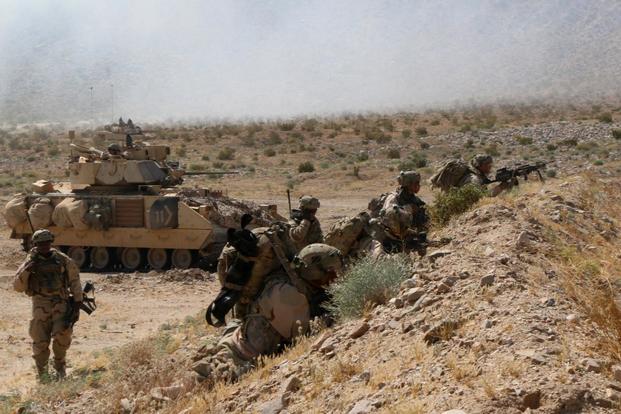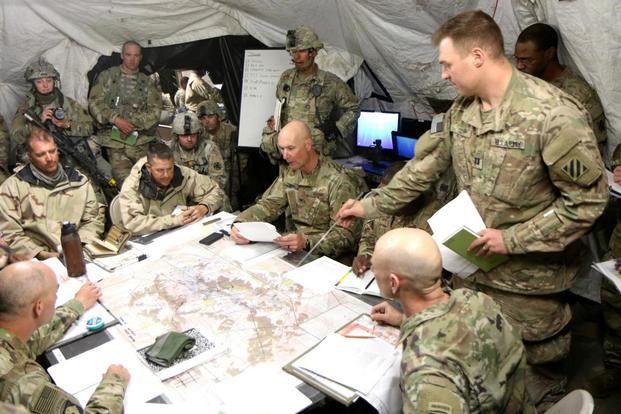FORT IRWIN, California -- If there is one piece of advice Col. Patrick O'Neal would offer to leaders coming to the National Training Center, it's that they should leave their pride at home station.
The commander of the 3rd Infantry Division's 2nd Armored Brigade Combat Team is on his fourth rotation to NTC, one of the Army's three combat training centers designed to push combat brigades to their limits and expose tactical weaknesses to improve combat proficiency.
1. Leave Your Pride at Home
"It's not to tell you how good you are; it's to tell you what you need to work on," said O'Neal on May 10 during a short break from planning his next move against enemy forces here. "That is what you want to know. If you just go through this and everybody says, 'Hey, you are so good,' at the end of it, we are not going to be a better organization.
"Don't let your ego get in the way of progress," he added.
This year, Army leaders placed a greater emphasis on sending more brigade combat teams to decisive-action rotations at NTC to prepare units to face potential near-peer adversaries such as Russia or China on a future battlefield.
At NTC, combat units are forced to operate in a battlespace the size of Rhode Island against an opposing force equipped with armored vehicles, artillery, drones and helicopters. The rapid pace of operations tests even the best units' ability to adapt as they try to seize key terrain and defend against enemy counterattacks.
2. Be Ready to Adapt to Anything
"What this place replicates for you is when you train to go to war, and you go to a war, and then it's not exactly what you trained for because the enemy gets a vote. The environment gets a vote. And no war we have really ever trained for is the war we have fought," O'Neal said. "Do you have a mental ability to adapt, which means you can understand your environment, orient on it and decide to change? A lot of people don't.
"Good organizations understand that the willingness and the ability to adapt is what makes them the strongest," he said.
Pfc. Paulin Schmit, a 23-year-old civil affairs specialist who came straight to NTC two weeks after arriving at her unit from Advanced Individual Training, said she would offer similar advice to any soldier coming to NTC.
3. 'Plan A' Will Change
"Be very flexible because things can change," she said, describing how most time schedules have to be altered because of changing conditions on the ground.
"Even if a plan is set in stone ... you have to have a plan B, C and D just in case, because you just never know what is going to happen," Schmit said.
Lt. Col. Arthur McGrue III, commander of 3rd Battalion, 15th Infantry Regiment, said he knew from past experience that his tactical operations center (TOC) would have to be extremely mobile.
On May 9, McGrue's headquarters "jumped" the TOC three times, a process that involves packing up the unit's computers, radios, command tent, lighting, generator and other essentials needed to monitor the battlefield, then moving it to a new location.
"The first time we jumped is because we received indirect fire, so we had to move from that location because that let us know that the enemy saw us," McGrue said. "The second time we jumped is because we needed to get closer to companies so that we could hear them -- with the type of terrain that is here, it was blocking some of those radio signals."
A potential chemical weapons threat forced the unit to move a third time, he said.
"We didn't get gassed, but we were close enough to an area that was gassed. So to prevent any downwind effects, we moved," he said.

4. Prior Training Will Come in Handy
A TOC can take up to two hours to break down and longer to stand up. McGrue's unit streamlined that during training so it takes 30-45 minutes to tear down and no longer than an hour to stand up, he said.
"That was one of the things we did in the train-up back in November timeframe," he said. "We had a training exercise where we went out and set this thing up and tore it down, set up and we tore it down."
When units come to NTC, they often struggle with coordinating key combined-arms capabilities, said Capt. Joshua Haseltine, an observer-controller who trains unit intel staff officers at NTC.
"A lot of teams back at the home station will train to specialties. ... We have intel guys, that I train, so they will find the enemy, but how well do they work with the fires guys or the ... [joint terminal attack controllers] to be able to actually integrate aviation, close-air support, artillery to take out or destroy a target?" he said. "So that is one thing we look at that typically teams struggle with."
5. Don’t Count on Getting the Supplies You Were Promised
Sgt. Tim Hohman would advise units not count on equipment that the Army promises it will provide once they arrive at NTC.
"The biggest piece of advice I would say is plan for what you have, not what you are told will be there," said Hohman, a civil affairs specialist on his second rotation at NTC.
"They will say, 'We are going to give you five cans for fuel, and we will give you four cans for water.' ... Plan on having the three to four cans you have yourself."
Communications headaches are also common in the mountainous, barren training space in the Mojave Desert, Hohman said.
Units typically get a lot of extra communications training prior to NTC, "but when you come out here, you usually bring a roll of chew or a carton of cigarettes or a bag of candy, and you are going to make friends with the battalion or brigade commo guy," he said.
"He is your best friend. You want him fat, dumb and happy because he is going to come and help you anytime you need it," Hohman said.
-- Matthew Cox can be reached at matthew.cox@military.com.












